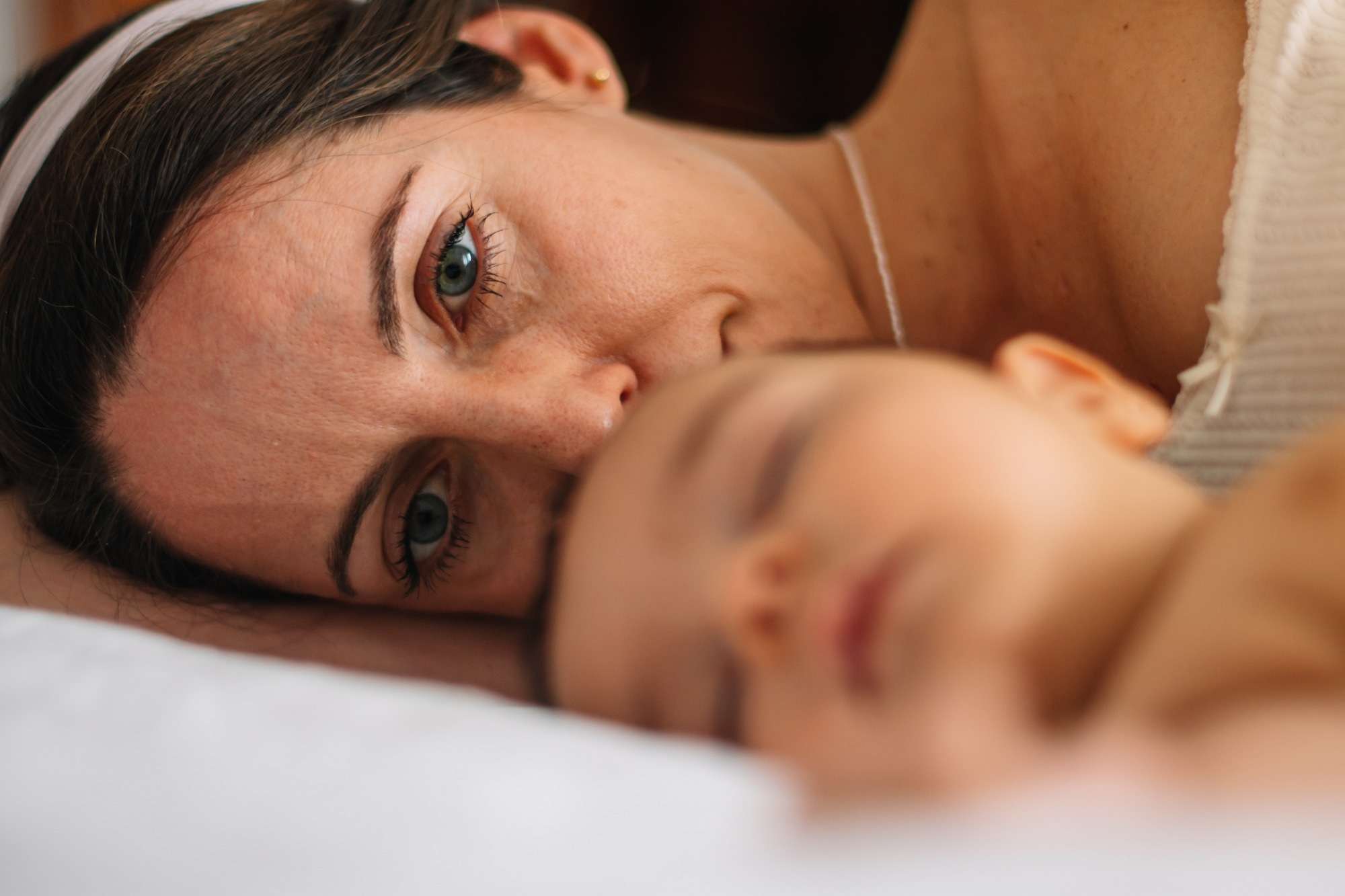Introduction
What is “mom brain”?
Hormonal regulation of maternal brain remodeling
Structural brain changes in pregnancy and postpartum
Cognitive and emotional outcomes
Functional brain reorganization for maternal behavior
Neuroplasticity beyond the postpartum period
Clinical implications and research gaps
Conclusions
References
Further reading
Discover how the maternal brain rewires itself during pregnancy and parenting, revealing that “mom brain” is a sign of remarkable adaptation, not decline.
 Image Credit: PeopleImages.com - Yuri A / Shutterstock.com
Image Credit: PeopleImages.com - Yuri A / Shutterstock.com
Introduction
This article examines the profound hormonal, structural, and functional brain changes that occur during pregnancy and postpartum, both of which are significant periods of brain reorganization in adult life.
What is “mom brain”?
"Mom brain" and "pregnancy brain" are colloquial terms used to describe observable cognitive changes like forgetfulness and mental fog that are often reported during pregnancy and postpartum periods.1 These symptoms are hypothesized to arise, at least in part, from morphological changes within the brain that may enhance maternal bonding, empathy, and responsiveness, though a direct causal link has not been conclusively established in humans.
The extent of this brain remodeling is dependent on fluctuating hormone levels that optimize certain behaviors to protect and nurture the infant.2 Environmental factors, including severe sleep deprivation, can dysregulate the brain's stress and inflammatory systems, which increases the risk of transforming this otherwise healthy adaptation into a clinical vulnerability.
Hormonal regulation of maternal brain remodeling
During pregnancy, steroid hormones such as estradiol and progesterone increase by more than 100-fold before dropping precipitously following childbirth.3 Neuropeptides and other hormones that are involved in social bonding and stress regulation, like oxytocin, prolactin, and cortisol, also rise during this period, with recent studies in animals and humans suggesting that these bioactive molecules may play key roles in maternal neuroplasticity, though precise mechanisms and causality in humans remain areas of active investigation.2
These hormonal shifts may directly facilitate synaptic plasticity, myelination, and adult neurogenesis. Estradiol and progesterone may also modulate neurotransmitter systems, which influence the structure and function of brain regions integral to social cognition and emotional regulation.3
Oxytocin is crucial for aligning maternal brains with infant cues, strengthening mother-infant bonds, and reducing maternal anxiety, thereby creating a neural environment that fosters responsive parenting.2
How the brain changes of motherhood help human survival | Dr. Lara Harvey | TEDxNashvilleWomen
Structural brain changes in pregnancy and postpartum
Neuroimaging studies leveraging magnetic resonance imaging (MRI) technologies have revealed widespread reductions in gray matter volume in pregnant women, with this change persisting for at least two years postpartum.4 Notably, these reductions are concentrated in specific neural networks previously associated with social cognition and the 'theory of mind', which include the anterior and posterior cortex, precuneus, superior temporal gyrus, and inferior frontal gyrus.2,4
These morphological changes represent an adaptive process of synaptic pruning and specialization that enhances neural efficiency to meet the complex demands of motherhood, with these processes analogous to the brain remodeling that occurs during adolescence.4 For example, relative gray matter volume changes have been correlated with the quality of postpartum maternal attachment, thus highlighting direct links between brain reorganization and caregiving behavior.2
Cognitive and emotional outcomes
Most women, particularly first-time mothers, report memory and attention decline consistent with the "mom brain" syndrome. However, objective evidence for the condition remains weak and inconsistent.
In one study using objective measures of cognitive performance to monitor mothers who reported "mom brain," researchers failed to identify any objective cognitive deficits, even one year postpartum. Thus, although maternal feelings can change, cognitive abilities may remain intact.1
Despite limited supporting data, the prevailing hypothesis within the scientific community is a neurocognitive trade-off. Rather than a holistic cognitive decline, the maternal brain reallocates resources towards infant-related stimuli.
This manifests as enhanced emotional salience for infant cues, heightened threat detection, and improved empathy.2 In contrast, attention to less salient and non-infant-related tasks is significantly reduced.
Functional brain reorganization for maternal behavior
Next-generation neurocognitive imaging, coupled with functional modeling, reveals that key regions in the maternal caregiving network, including the amygdala, prefrontal cortex, and hypothalamus, are recalibrated to support maternal behaviors.2
Unlike hormone-mediated structural remodeling, the success of functional reorganization is highly dependent on environmental inputs, such as stress and sleep. Sleep and mood regulation have a strong bidirectional relationship, with extreme postpartum-associated sleep disruption capable of dysregulating the same systems undergoing remodeling.5
Chronic sleep deprivation can lead to hyperactivity of the hypothalamic-pituitary-adrenal (HPA) axis, resulting in elevated cortisol levels and impaired function of the prefrontal cortex and hippocampus.5 Systemic inflammation and disruptions in monoaminergic neurotransmitter systems that affect serotonin and cortisol levels are other known consequences of poor sleep, all of which can destabilize normal emotional responses and mood stability.
Together, these processes create a positive feedback loop, wherein poor sleep exacerbates stress and inflammation, which further disrupts sleep and increases the risk of perinatal mood disorders.5 Even the mother's own early life experiences may lead to intergenerational effects, as observed in one study reporting associations between maternal childhood abuse and altered infant brain development.6
Neuroplasticity beyond the postpartum period
Maternal brain plasticity is not confined to only pregnancy or the immediate postpartum period, with evidence of motherhood-linked structural remodelling persisting for six years or more.4 Some scientific evidence suggests that parity, which is defined as the total number of offspring, and remodeling intensity may determine the persistence of ‘mom brain’ symptoms.
A recent scoping review of parenting-associated neurobiological changes revealed that caregiving-induced neuroplasticity is not exclusive to birth mothers. In fact, fathers may similarly exhibit hormonal and neural adaptations during the postpartum period, particularly those who actively engage in infant care, that are analogous to those occurring in the maternal caregiving system.7
Similar observations have been reported among foster mothers, suggesting that the experience of active caregiving itself, independent of pregnancy and childbirth, is a powerful driver of brain reorganization in humans.7
Clinical implications and research gaps
A persistent clinical and research challenge is distinguishing between the adaptive neural changes of typical motherhood and maladaptive patterns associated with perinatal mental health disorders. Perinatal depression and anxiety occur as a result of distinct alterations in brain activity, particularly regions related to mood and anxiety regulation, and impact an alarming number of new mothers.5
Severe sleep disruption can transform otherwise adaptive motherhood-associated neuroplasticity toward maladaptive perinatal disorders.5 Emerging evidence suggests that sleep quality-targeting interventions may help normalize HPA axis function and reduce neuroinflammation, thereby potentially mitigating the risk of perinatal depression, though more research is needed to confirm effectiveness.5,8
Most current neuroimaging literature focuses on high-income, homogeneous samples, thereby limiting the generalizability of outcomes. Furthermore, most studies are observational, with only limited longitudinal data available.4
Future research that leverages fundamental neuroscience is needed to generate in-depth maps of maternal brain changes. Developing and testing targeted and accessible interventions for factors such as sleep disruption could also improve outcomes for both the mother and the child.9
 Image Credit: Alberto_Rodriguez / Shutterstock.com
Image Credit: Alberto_Rodriguez / Shutterstock.com
Conclusions
The profound expansion in neuroplasticity during motherhood arises due to an adaptive remodeling of the brain's structure and function. These alterations are the product of both hormones and experiences designed to foster maternal behavior and improve parenting-associated traits.
The bidirectional link between sleep quality and depressive symptoms demonstrates that environmental factors can either support or undermine this critical neurodevelopmental period. Public education is essential to reframe "mom brain" as an adaptation, while clinical practice must recognize and treat disruptive factors like severe sleep deprivation for holistically improved outcomes.
References
- Orchard, E. R., Ward, P. G., Egan, G. F., & Jamadar, S. D. (2021). Evidence of subjective, but not objective, cognitive deficit in new mothers at one-year postpartum. Cold Spring Harbor Laboratory. DOI:10.1101/2021.06.07.447303, https://www.biorxiv.org/content/10.1101/2021.06.07.447303v2.full
- Barba-Müller, E., Craddock, S., Carmona, S., & Hoekzema, E. (2018). Brain plasticity in pregnancy and the postpartum period: links to maternal caregiving and mental health. Archives of Women's Mental Health, 22(2), 289–299. DOI:10.1007/s00737-018-0889-z, https://link.springer.com/article/10.1007/s00737-018-0889-z
- Chiang, Y.-T., Chen, J.-H., & Chen, K.-H. (2025). The Molecular and Cellular Basis of Physiological Changes in Pregnancy and Its Implications in Neurologic and Ophthalmic Pathologies. International Journal of Molecular Sciences, 26(11), 5220. DOI:10.3390/ijms26115220, https://www.mdpi.com/1422-0067/26/11/5220
- Martínez-García, M., Paternina-Die, M., Desco, M., Vilarroya, O., & Carmona, S. (2021). Characterizing the Brain Structural Adaptations Across the Motherhood Transition. Frontiers in Global Women's Health, 2. DOI:10.3389/fgwh.2021.742775, https://www.frontiersin.org/journals/global-womens-health/articles/10.3389/fgwh.2021.742775/full
- Yasugaki, S., Okamura, H., Kaneko, A., & Hayashi, Y. (2025). Bidirectional relationship between sleep and depression. Neuroscience Research, 211, 57–64. DOI:10.1016/j.neures.2023.04.006, https://www.sciencedirect.com/science/article/pii/S0168010223000871
- Lyons-Ruth, K., Li, F. H., Khoury, J. E., Ahtam, B., Sisitsky, M., Ou, Y., Enlow, M. B., & Grant, E. (2023). Maternal Childhood Abuse Versus Neglect Associated with Differential Patterns of Infant Brain Development. Research on Child and Adolescent Psychopathology, 51(12), 1919–1932. DOI:10.1007/s10802-023-01041-4, https://link.springer.com/article/10.1007/s10802-023-01041-4
- Sobral, M., Pacheco, F., Perry, B., Antunes, J., Martins, S., Guiomar, R., Soares, I., Sampaio, A., Mesquita, A., & Ganho-Ávila, A. (2022). Neurobiological Correlates of Fatherhood During the Postpartum Period: A Scoping Review. Frontiers in Psychology, 13. DOI:10.3389/fpsyg.2022.745767, https://www.frontiersin.org/journals/psychology/articles/10.3389/fpsyg.2022.745767/full
- Ballesteros, C., Paternina-Die, M., Martínez-García, M., López-Montoya, G., Noguero, I., Desco, M., Vilarroya, O., de Blas, D. M., & Carmona, S. (2025). Linking birth experience and perinatal depression symptoms to neuroanatomical changes in hippocampus and amygdala. Science Advances, 11(10). DOI: 10.1126/sciadv.adt5619, https://www.science.org/doi/10.1126/sciadv.adt5619
- Prinstein, M. J. (Ed.). (2022). The Portable Mentor. Cambridge University Press. DOI: 10.1017/9781108903264, https://www.cambridge.org/core/books/portable-mentor/ECDDAE8E98903C16930434A5905F7273
Further Reading
Last Updated: Jul 28, 2025